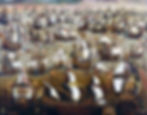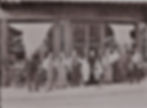Calvados is an apple brandy traditionally made in Normandy, France. It is also the name of the French region, or department, famed for its apple trees, the Bayeux tapestry and the beaches where the Allies landed on D-Day during World War II.

There is a fabulous legend around how the name calvados came about. It’s said that in 1588, a Spanish carrack called San Salvador – one of the biggest ships in the Spanish Armada – was wrecked off the Normandy coast. The locals ‘salvaged’ the valuables and even named the fated rocks after the ship. Over time, the word Salvador changed to ‘calvador", then eventually to ‘calvados’. It’s a great story, given added credibility by the name sounding Spanish, but is it true?

To uncover the truth, we’ll need to head back to the 16th century. Philip II of Spain and Elizabeth I of England were at war (yes, of course it was over religion). Philip is planning a vast invasion, and assembled 141 warships called the Spanish Armada, the largest fleet ever seen in Europe and considered invincible. On 28th May 1588, around 10,000 sailors and 20,000 soldiers left Lisbon bound for the English Channel. According to records, there were two ships called San Salvador in the fleet. One was a 24-gun ship from the squadron of Urcas and the other was our carrack from the Guipúzcoan squadron. Not much is documented about the former but the latter played an incidental role in the outcome of the epic sea battle.
In mid-July, the Armada was spotted off the Cornish coast and great beacons were lit all along the south coast to warn the English fleet. Sir Charles Howard led the defence, with the more famous Sir Francis Drake as his second-in-command. The first skirmish occurred on 21st July, with the Armada attacking in a hard-to-break crescent formation.

Despite much cannon fire, and loss of life, the day’s fighting ended with neither side losing a ship except… the San Salvador. During a lull in the battle, the ship’s gunpowder magazine accidentally exploded, killing 49 sailors outright, and starting a fire that was said to have raged all night. Luckily, most of the crew were rescued but the ship was ordered to be scuttled the following day. Instead, and against orders, it was simply set adrift in the English Channel. So, could it have eventually been swept onto the Normandy rocks? Alas, no, it was found by the English and towed to Weymouth by the Bark Flemyng (later renamed the Golden Hind) as a great prize – an early PR coup that added resolve and energy to England’s cause.
“This Monday, being the 22nd of July, 1588, the Spaniards abandoned the ship that the day before was spoiled by fire, to which his Lordship sent the Lord Thomas Howard and Sir John Hawkyns, knight, … went aboard her, where they saw a very pitiful sight - the deck of the ship fallen down, the steerage broken, the stern blown out and about 50 poor creatures burnt with powder in most miserable sort. The stink in the ship was so unsavoury, and the sight within board so ugly, that they shortly departed … and the said ship brought into Weymouth the next day.”
A Relation of Proceedings. BM Cotton Julius F x. ff.111-117.

Of course, the attempted invasion by the Armada was an unmitigated disaster for the Spanish. Of the 141 ships that set sail, only around 65 returned to Lisbon, the result of bad weather, bad logistics, bad naval strategy or just bad luck. A few were wrecked, but nowhere near Normandy and not called San Salvador, so the story sadly seems to be a bit of marvellous etymological make-believe.
More probably and prosaically, the name calvados was derived from the Latin calva dorsa, meaning bare backs, which relates to topography. It either refers to a long rocky plateau off the Normandy coastline which, during a ‘high’ low tide, reveals two bare rocks. Or, as read on a 17th century map, it’s named after two bare portions of a cliff between Sainte-Honorine-des-Pertes and Saint-Côme-de-Fresné. Either way, the calva dorsa were visible and recognisable seamarks for sailors to navigate the coastline.

(Oh, and while we’re talking about etymology, the name Normandy is a derivation of ‘Norsemen’ or ‘north men’ – coined when the Scandinavian Vikings raided, ruled and settled this part of the French coast in Medieval times of 8th and 9th centuries. Crazy, huh?).
But back to apples…
The first written reference to apple cider distillation in Normandy can be found in a manuscript dating from 1553. It wasn’t called calvados yet (that wouldn’t officially come for another 237 years) but it described the process.
The author was a man called Gilles Picot, later Gilles de Gouberville, a French noble and diarist from Cotentin. The hand-written account was his livre de raison, a household and estate’s accounting book that also included personal notes and snippets of news – like a daily diary and balance sheet all rolled into one.

It’s a rare and important document that gives us a first-hand insight into the life of a country squire in Normandy during the 16th century. In it, it’s clear he loved his fruit trees and nurseries, spending much time planting apple trees, propagating new varieties and pressing cider.
On 27th March 1553, his journal tells us that: “In the morning Master François and Messire Jean Auvray went to Morsalines to ask me for the transplants of Piscey and Dameret”.
He mentions learning the art of distillation from a young man called François Le Tourangeau, a worker employed by him for a few years, who knew how to distil wine. In April 1554, François tells Gilles how to make alambi (the alembic pot stills) and associated equipment. From here he is credited with the ‘invention’ of cider eau-de-vie. But of course, as with most accounts, just because he was the first to write about cider distillation doesn’t mean he was the first to do it – Normandy farmers had almost certainly been distilling for a good while previously.
Apples have always been revered in Normandy. The region’s perfect terroir and mild climate led to the planting of more apple trees in this region than anywhere else in France. It proved a vital source of food and trade – apples could keep well through colder winter months but also be made into cider to be traded in thriving ports like Cherbourg, a regular stop for Spanish merchants.
If we go back a few hundred years to the beginning on the fourteenth century, there are detailed descriptions of apple growing, with up to 300 varieties being grown in Normandy. Locals were starting to experiment with different varieties to create different ciders classified by the apple name and producer. Sailors and traders, particularly from the Basque region, also added to the mix by bringing new spicier varieties that ultimately proved better suited for cider making.
One of those early pioneers was a man called Guillaume D’Ursus (or Dursus), who’d hailed from Navarre in northern Spain but settled in Normandy after being gifted lands by Louis XII in 1522. He grafted new varieties, like the Barbarie de Biscaye and Bisquet, and introduced new cultivating techniques that greatly improved the taste and quality of cider in the region.
Building on his good work, cider’s reputation went from strength to strength. In 1588 Julien de Paulmier, often referred to as the father of cider pomology, published the world’s first dedicated pamphlet on the drink called De Vino et Pomaco (Treaty of Wine and Cider).

Originally from Normandy (so already a bit biased), he was also Charles IX and prince Henry III’s physician, so had the ear and influence of the court. Convinced that it was cider that had cured him of his own heart palpitations, he continually promoted it far and wide for its medicinal qualities – starting its reputation for being a ‘healthier’ spirit that remains to this day.
It helped that wine was going through a tumultuous time in France too. Wine was being taxed heavily, so a lot of vineyards were uprooted in the late sixteenth century, meaning the thirsty population turned to cider, relying on Normandy for the best stuff.
Throughout the next couple of centuries, cider eau-de-vie (as it used to be called) was used solely for local and personal consumption in and around Normandy. But as its reputation gradually grew beyond the region, a statesman called Jean-Baptiste Colbert, Louis XIV’s Minister of Finance, first taxed then banned its export in 1681 and 1687 so he could promote the more lucrative cognac and Armagnac trade. This self-serving ban stayed in place until 1741.
It was an annoying piece of legislature, setting calvados’ reputation back tenfold. By not being allowed to flourish like other French spirits, it began to be seen as the poor man’s cognac and inferior in quality, which wasn’t the case.
But hope was on the horizon. About fifty years later, the word calvados was finally used loudly and proudly for the first time. Up until the late 18th century, France, like other European countries, was ruled by a monarchy and run by feudalism. The French Revolution put an end to that. It was a time of social, economic and political change. The new ruling regime, called the National Assembly, wanted equality, unity and simplification and started by redrawing the French map – literally!
Based on the map drawn by cartographer Mathias Robert de Hesseln, the country was divided into 81 departments, each about 70km wide and subdivided into nine districts. The Assembly had strict rules on names too, deciding that they shouldn’t hint at anything historic but should instead evoke the natural features of the region. This was decreed on 26th February and written into the constitution on 4th March 1790. Calvados, the department, had been born (narrowly avoiding the rather ignominious name of ‘Orne-Inférieure’).

From here on in, calvados enjoyed its moment in the sun. It was written about by French literary greats such as Gustave Flaubert (who was born in Normandy), Emile Zola and Guy de Maupassant to name a few, gradually increasing its quality perceptions along the way.
By 1900, there were around 100,000 distillers in Normandy. Of course, wars and taxes and inconsistent production (the really strong agricultural stuff was locally known as ‘calva’) undermined its good name after that, but still… it all eventually led to Calvados getting an Appellation d’Origine Contrôlée (AOC) – just like its more prestigious cousins champagne and cognac.

This was a strict set of rules and classifications that limited where and how it can be produced, which protected its good name. The AOC was awarded on 11th September 1984 and meant – amongst other things – that calvados must be traditionally made in the Calvados department, be aged for at least two years in French oak barrels (though most are aged for much longer, upwards of 20 years) and be a minimum of 40% ABV.
And like cognac, it has quality classifications that relate to its age and stage:
Fine: At least 2 years
Vieux or Réserve: At least 3 years
V.S.O.P., V.O. or Vielle Réserve: At least 4 years
X.O., Napoléon or Hors d’age: At least 6 years
Millésime: Vintage Calvados
Like most drinks, calvados is steeped in history, its reputation and fortunes forever dependent on royal patronage, weather patterns and agricultural pioneers. While still never quite achieving the global fame of other French spirits, it not only survived but thrived amid the turmoil – and has emerged as the apple of the eye of sophisticated gourmands around the world, now considered an equal to cognac. Not bad for a humble apple brandy once only drunk by gruff local Normandy farmers.
Santé!
